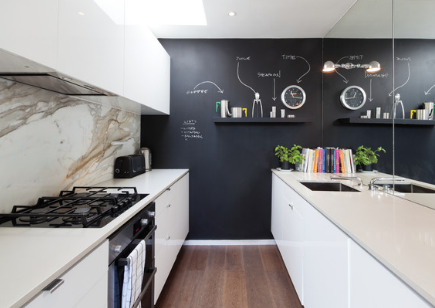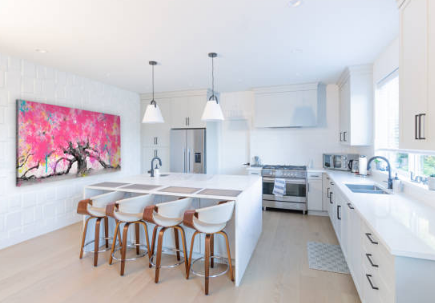The kitchen consists of two parallel cabinets that form a central corridor for work. The kitchen layout is suitable for all kitchen styles; It is also the preferred design for many professional chefs, who like this layout because it improves safety and efficiency during cooking. Just like the compact galleys on boats, this layout is named after this, and the galley design also optimizes space by accommodating a lot of storage space and countertop areas, making it ideal for small galleys. If you are considering a kitchen layout or are remodeling your inherited kitchen layout, here are some things you should know.

Evaluate your space. While kitchens are best suited for small spaces, they are also suitable for medium-sized kitchens. However, be aware that if the relative running distances are too far, the kitchen will lose efficiency and become an obstacle rather than a help. (The kitchen shown above is correct.) )
Also know that kitchen layouts are often enclosed with no room for a dining area. This means that if an open space is not possible, then it may not be the most socially appropriate arrangement. However, a kitchen layout in an open space can provide the best of both worlds.

Choose your preferred kitchen look: symmetry. When it comes to kitchens, people have two layout preferences. The first one is relatively symmetrical, as shown in the figure. This usually means that the length of the line and the arrangement of the cabinets on each side will mirror each other as closely as possible – or depending on your needs.

Asymmetry. You can choose an asymmetrical layout using a variety of methods. For example, if you have an open space, as shown in the image, you can use a mix of tall and upper cabinets on one side and only a lower cabinet on the other side. Alternatively, you can place a tall cabinet or a bunch of appliances on one side of the room, while the lower and upper cabinets on the other side, as shown.

Place the tall cabinet on one wall. If you’re designing a kitchen like the one above, it’s best to go with a wall length of at least 12 feet so that the sink and stove can be kept far enough apart from each other. To be on the safe side, they should be at least a foot apart, but since this doesn’t leave any space to work with, we always try to place them more than 3 feet apart. In this arrangement, a length of about 12 feet will allow for adequate sink capacity, cabinets or drawers under the cooktop (in which case the top drawer sometimes needs to be adjusted), and it ensures that all major appliances fit.
Finally, the 12 feet provide space for the units opposite: such as refrigerators, oven enclosures, and pantry. This arrangement provides ample storage space and helps keep the kitchen tidy and the countertops tidy.

Break the run. You may prefer an asymmetrical layout, where full-length cabinets and lower cabinets are placed along the same wall. For example, if a wall is just over 12 feet long, it may have three full-length cabinets at one end and three lower cabinets at the other. Usually, there will be upper cabinets, floating shelves, or windows above the lower cabinet. On the other side, you can have upper cabinets, shelves, windows, and even transparent walls.
This arrangement is very effective if the kitchen is very cramped, as the space will feel more open when entering the kitchen without tall cabinets.

Use the kitchen hallway. Depending on the layout of your home, one end of the kitchen may or may not close. If the far end leads to another room or garden, the traffic for that passage will be more congested.
Depending on the number of people in your household, this may not be a problem, but if you have small children or pets, you don’t want them to rush into the kitchen while you’re holding a sharp knife or boiling kettle. You can enhance the security of your layout by planning your kitchen’s sink and stove in the same location, especially if the hallway is very narrow. While less efficient than placing them facing each other, this arrangement concentrates your appliances in one area, so you don’t have to turn to the opposite side with potentially dangerous kitchenware in your hands.

Strengthen the walls of the closed kitchen. A kitchen enclosed at one end may be a safer layout because there is only one entrance, allowing the chef to be more aware of other people’s coming in and out. But how do you make the most of this wall space? Maybe there is a window here, in which case it is important not to block the natural light from the kitchen. Adding a stool allows you to sit at the far end to write a shopping list or sit down on a phone call.
Alternatively, there may be space for an open bookshelf, a beautiful painting, or a family-friendly chalkboard wall, as shown below, that can be used for fun drawings and notes, or for shopping or a to-do list.
The clever use of the mirror on the right side of this compact kitchen is also noteworthy; It gives the impression that the space is larger.

Create a kitchen with an island. I’ve already mentioned that a closed kitchen may not be the most socially friendly environment for chefs. Therefore, a popular modification to the kitchen kitchen is the addition of a kitchen island, where space allows.
In this case, the island replaced one of the runways and became part of the layout and function of the kitchen. The island runs parallel to the longer cabinets, often fitted with stoves or sinks. Wherever the position is not here, it will be staggered in the opposite run, not directly opposite. This staggering is safer and more efficient during the cooking process because it reduces the distance required for the user to turn between the sink and the hob.

Make your kitchen social. Some homeowners want to add an island to their kitchen layout, but want to keep the extra work surfaces clean. This is often the case with bakers, who like to use this space to roll pastries.
This is part of the goal of the kitchen seen here, which is designed for professional recipe developers who work from home. Her kitchen also had to accommodate the needs of her husband and two young children, and the seating at the far end of the island helped with this, keeping the kids safely away from the cooking area, but ensuring a more socially friendly arrangement than the standard kitchen has.

Add a seat. Sometimes there will be space in the kitchen for a small peninsula or breakfast bar, providing additional storage and dining space. Here, the peninsula at the far end of the kitchen is completely away from the cooking area and has seating at the far end. (It can also double as a slaughtering table.) )
This sometimes works if there is space to add a table between the relative runs of the kitchen. However, you need to be careful when planning your space, as tables can be much less efficient if they push your work surfaces too far.
Adding a trolley as an extra worktop can be an effective alternative, although in most cases, there’s plenty of counter space in the kitchen to eliminate this need – unless it’s a specialized addition like a slaughter table.

Enhance the sense of space. When considering kitchen layouts, homeowners are eager to avoid the “hallway” effect, where the kitchen feels small and closed. But even in small spaces, this can be avoided.
As already mentioned, losing the continuity of the tall cabinets in favor of the upper cabinets or shelves will help to open up the space. The choice of furniture also helps: light, high-gloss finishes are best for reflecting light and enhancing the sense of space. Similarly, handleless doors and drawers have clean lines and take up less physical space than doors and drawers with handles.
Finally, lighting is important. Large, well-placed lighting will soften the appearance of the kitchen and create the impression of more space.


